Last Updated on 11/10/2025
Vrindavan is one of the holiest places in India but why is that so? Hindu deity Lord Krishna had spent a major part of his childhood in this small, humble town next to Yamuna. Almost every street, monument, statue, and temple in Vrindavan is related in some way or the other to the Lord. Krishna devotees from around the world find peace and solace in this pious town where spirituality and religion meets history. There are numerous temples dedicated to every aspect of Krishna in the form of various big, small, old, and new temples like Prem Mandir, Banke Bihari Temple, Govardhan Temple, and many more.
Being situated close to the notorious Yamuna River, Vrindavan is also home to numerous Ghats. Along with temple visit if you take your time and explore the Ghats of Vrindavan, then check out these Ghats for a deeper and a more clear view into the history, legend, and mythological importance of Vrindavan this place holds in the life of Krishna devotees and explorers in general:
Top 17 Most Beautiful Ghats of Vrindavan
- Keshi Ghat
- Radha Bagh Ghat
- Sri Andhra Chat Ghat
- Kaliya Daman Ghat
- Sri Varaha Ghat
- Chir Ghat
- Bihari Ghat
- Surya Ghat
- Gopal Ghat
- Govind Ghat
- Bhramar Ghat
- Imli Tala Ghat
- Yugal Ghat
- Sri Raj Ghat
- Adi Badri Ghat
- Sri Jagannath Ghat
- Shringar Vat Ghat
1. Keshi Ghat
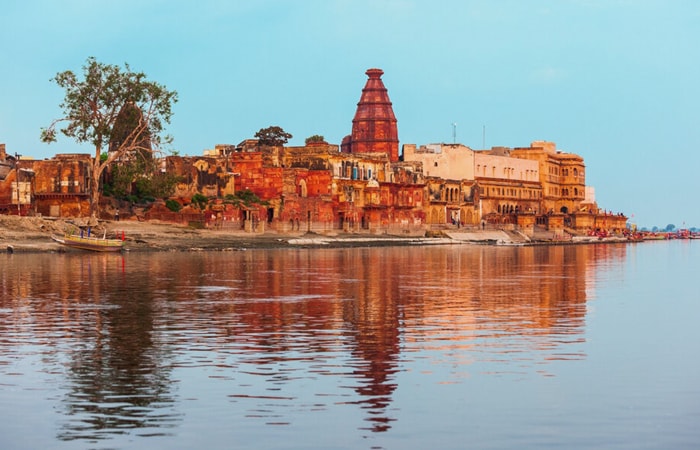
Keshi Ghat is the most famous and prominent bathing Ghats of Vrindavan. Gracing the banks of Yamuna River, Keshi Ghat is not only a significant spot for devotees to take a holy dip but also one of the prettiest and well-made Ghats here. Set against the backdrop of Madanmohan temple, the Ghat is made with incredibly detailed and finely carved out inlaid stone work which further beautifies the entire environment. The Ghat is so important that anyone who sees it, takes a bath in it, drinks its water or even gets a whiff of the water here, is purified. The ghat is named after a legendary incident where Lord Krishna is said to have killed the demon Keshi by choking him with a lotus flower. The lord had then made his way to the spot where Keshi Ghat currently stands and had taken a bath purifying his soul.
2. Radha Bagh Ghat
Every path, lane or establishment in Vrindavan, Mathura, and most of its vicinity reminds and deeply resonates with the historical and legendary past this place is associated with. Radha Bagh Ghat is one such historically significant Ghat located in the backyard of the Radha Rani Mandir in Barsana, a small holy town located in very close proximity to the main city of Vrindavan. The place gives an otherworldly vibe because it is surrounded by not only the holy sthalams but also with lush green and age-old tree groves. The beauty of this place is amplified by the presence of numerous peacocks which is reminiscent of the lord since peacocks are associated with Lord Krishna. The Ghat is a beautiful place to just sit back, relax and watch the peacocks (associated with Lord Krishna) fly by.
3. Sri Andhra Chat Ghat
Radha and Krishna are known for having loving fights and were very playful with each other. Many of their depictions show them running around and having a playful banter with each other. Vrindavan was the place where Lord Krishna grew up playing and fooling around with Radha. Sri Andhra Chat Ghat is a small, lesser popular Ghat in Vrindavan where Radha and Krishna used to play hide and seek in and around the Ghat. This aspect of Krishna’s life forms a major part of his personality and offers the devotees a small glimpse into the glorious life of Kanha. The Ghat also functions as a Chhath Ghat during the holy occasion for the people of eastern India.
4. Kaliya Daman Ghat
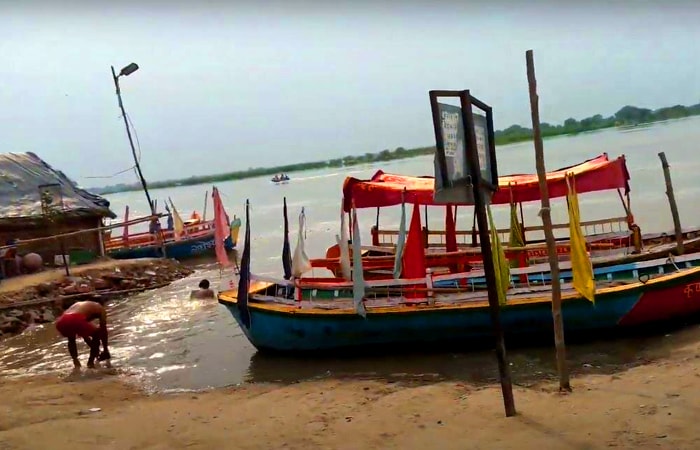
Kaliya Daman Ghat is another one of the most important and holiest of all Ghats in Vrindavan. A major historical event related to the life and time of Krishna had taken place on this very Ghat. The Ghat is named after a demon snake creature that the Lord had fought and subdued. The thousand hooded snake is said to have made the Yamuna River its new home and spit poison into the life-giving river source for the rest of the town of Vrindavan and had the snake continued doing so, it would have put the lives of several innocent locals in danger. Krishna sat on the Ghat and fought the thousand-headed snake and ended up killing it and saving the lives of many. After the completion of the fight, the Lord himself was seen dancing on top of the demon snake’s head. While planning a trip to Vrindavan make sure to go to this Ghat and learn more about the incredible past of Krishna’s hometown.
5. Sri Varaha Ghat
Varaha is a boar avatar of Lord Vishnu which is also depicted as the 3rd avatar in the Dashavatar form. Gracing the southwestern bank of Yamuna River that runs and fuels life in the lives of the locals in Vrindavan, Varaha Ghat Temple can be seen in the southwestern end of Sri Vrindavan, in the old Yamuna banks. The Ghat is named after the incident when Lord Krishna had transcended into the life form of a wild boar for every gopi’s pleasure. Another story says that during the sat yug era, a demon had shaken the hard really violently which flicked the earth off its orbit and deep into the bottom of universe which meant impure conditions for the gods. During that time the wild boar a.k.a Lord Krishna picked up the earth from the deep trenches and back into its orbit.
6. Cheer Ghat
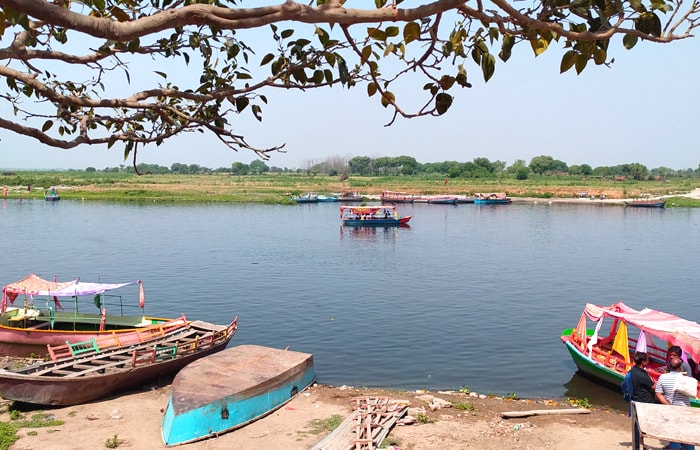
Continuing the list of important Ghats in Vrindavan, Chir Ghat had to be mentioned. This prominent Ghat in Vrindavan is located very close to the iconic Keshi Ghat and very close to Radha Damodar Temple. If you are familiar with the story about Lord Krishna joking around with the Gopis taking a bath in the lakes of Vrindavan, then this is the place where it used to happen a major part of the time. The Kadamba Tree, where Krishna used to sit with the Gopi’s clothing can still be seen there. Devotees can be seen tying holy red colored clothes if they want their wishes to be fulfilled and for women it is believed that doing this will get girls good grooms for the future. Going to this Ghat will be a very eye-opening experience for many.
7. Bihari Ghat
Bihari Ghat is named after the temple where the Ghat is located which is the Yugal Bihari Temple. Sri Yugal Kishore Ji temple is one of the oldest standing temples in Vrindavan which was built in 1627. Some credit for the creation of the temple and Ghat goes to the Mughal emperor Akbar, who had visited this temple during the 1500s and had ordered the temple to be built. The Ghat is also located so close to Keshi Ghat that it can be easily confused with Keshi. The story of the temple goes back to the time of Akbar rule when the Vaishnav community had asked the king for his permission to build the temple and instead of one he gave permission to build 4 temples.
8. Surya Ghat
Located very close to Madan Mohan Temple is Surya Ghat and the city holds a very special space in the hearts of Krishna devotees. According to written records and ancient mythological writings, Lord Krishna spent a lot of time soaking up the sun in this Ghat. Especially after the Kaliya Daman Fight, Lord Krishna was soaking wet and he laid down on the Ghat to properly dry himself off. This was also the time when Surya Dev came out in full power in an attempt to completely and properly dry out the lord. This goes on to show the importance of this place and why devotees make their way here to offer their prayer to the Lord himself.
9. Gopal Ghat
There are many aspects of Krishna’s life centered around the small villages of Vrindavan and Mathura. Even the places where he used to casually spend time are extremely holy for the devotees and local residents as well. Named after the loving name of Krishna, Gopal, the Ghat signifies another important account of his life. Gopal Ghat is the same location where an extremely overjoyed Nand baba had offered a couple of cows to the Brahmans nearby after having found out that his son Krishna was alive even after a very lengthy underwater fight with the thousand-headed demon serpent. This makes the Ghat an incredibly holy spot for not just devotees but also for anyone who believes in the lord.
10. Govind Ghat
Govind Ghat is another one of the important Ghats in Vrindavan although it is not as popular or well known as the others. This was the place where Radha Ji had come back to meet with Lord Krishna. Due to some emergency, she had to leave him behind in the middle of a raas which had made the lord very sad. The Ghat in a way signifies the happiness that was felt by the lord on the return of his lover after a long and desperate wait. You can go there, spend time soaking in the piousness and holy value of this place.
11. Bhramar Ghat
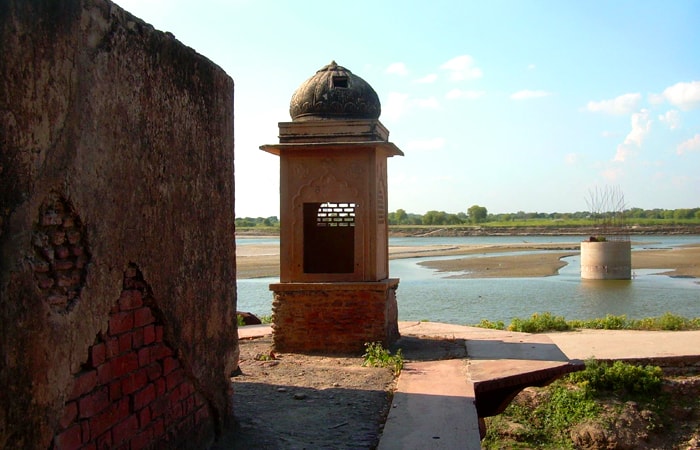
You may know Ghats as the steps leading from the main road and into the river and unlike regular steps these have a whole lot of historical and mythological significance associated with them. Unlike other Ghats, Bhramar Ghat looks like a simple and humble river side with the land leading you up to the river side with the absence of the regular steps. This is an incredibly idyllic spot which is surrounded by lots of greenery, colorful flowers, plants and other flora collections. The reason behind the naming of the Ghat Bhramar is the fact that these flowers and trees attract swarms of bumble bees which creates that buzzing sound from where the Ghat gets its name from.
12. Imli Tala Ghat
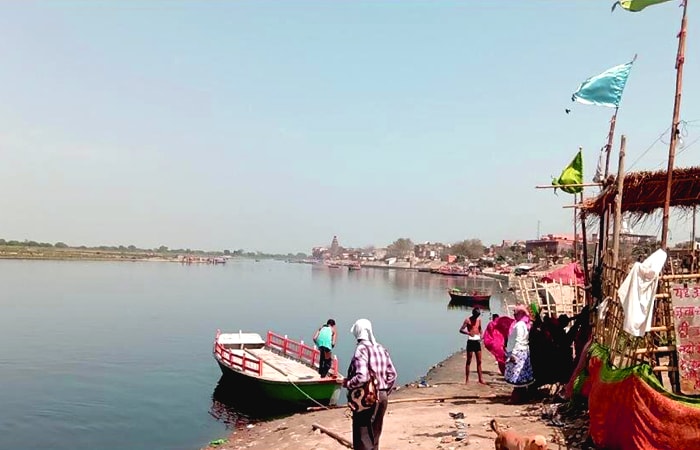
Imli Tala Ghat is all about epitomizing an anguish of intense love felt by Krishna and Radha during their separation time period. Simply translated, Imli Tala means tamarind tree, which merely describes the surroundings of this place. However, according to Indian mythological references, Imli Tala symbolizes the time when Radha Raani had to leave the sharad Purnima raas dance leaving Krishna feeling intense pangs of separation and sadness. Although the Ghat is not immediately present right next to the course of Yamuna River, since the river has changed its course over a long period of time, it is still an important part for Krishna devotees who come here to reminisce about that golden period while also offering their prayer to the lord and taking his blessings.
13. Yugal Ghat
Yugal Kishore temple is one of the many temples located in Vrindavan that is incredibly famous for its mythological importance and relation to the life stories of Lord Krishna. The temple is majestic, huge, and very well made. Located right in the back side of the temple complex is the Yugal Ghat. The Ghat is famous for many different reasons and religious values. According to mythological accounts and available written records, the divine couple, Radha Krishan, used to bathe together in the waters of Yamuna River right at this spot. People also believe that if you take a bath in the waters of Yugal Ghat you may spot the divine couple taking a bath themselves. Watching the sun setting on the horizon here is an experience in itself.
14. Sri Raj Ghat
Sri Raj Ghat in Vrindavan is another one of the places where Krishna would play one of his many games with the Gopis here. During one of his fun charades, Lord Krishna had disguised himself as a boatman in order to take the Gopis across the river on boat. He did so by covering himself in large cloaks in order to confuse the Gopis and protect his identity. The boatman demanded to wash the feet of one of the Gopis in exchange for taking the group of Gopis across the Yamuna River to sell their milk products in the market. He chose Radha Rani’s feet to wash, after which the Gopis and the disguised lord were on their way. In the middle of rowing, Krishna demanded he wanted to eat the milk products because he was weak, after eating some products he laid down in a slump saying he was sleepy after all that eating. This angered the Gopis who then removed the huge cloak from the lord’s face and saw Krishna pulling a prank on them.
15. Adi Badri Ghat
You may already be familiar with the term Adi Badri, which means the Badrinath of the future. You may already know that Lord Krishna is an avatar of Lord Vishnu, who had said that he would be coming back to earth in different forms throughout the duration of earth’s existence. The Adi Badri Ghat is a secluded little Ghat with very little tourist footfall. Located in the southern edge of the holy town of Vrindavan, where now you can see many different sadhus and sages performing meditation and yoga around the vicinity of the Ghat. This Ghat is the place where the Lord had appeared in the form of Adi Badri at the request of his precious Gopis.
16. Sri Jagannath Ghat
By now you may know that almost every Ghat has some major or minor significance related to the life and times of Lord Krishna. The story behind this Ghat is an interesting one. The story starts with one of the sages or a Brahman having a dream about Lord Jagannath where he was seen asking the sage to grant him a wish to take him to Vrindavan. During that time the Jagannath Temple of Orissa was very popular (and still is) since it is the eastern pillar of the holy Char Dham Yatra. The hermit then contacted the priest at the Jagannath Temple in Orissa and narrated the entire story to him who then suggested he should take this up with the king of Orissa then. He only agreed to do so if Lord Jagannath had appeared in his dreams and instructed the king to do so. Magically it happened and the king allowed the hermit to get a beautiful temple and a Ghat constructed dedicated to Lord Jagannath.
17. Shringar Vat Ghat
Many Ghats in Vrindavan are either named after the lord himself, the Gopis, Radha, or the activity that was performed by the lord in that very place. Literally translated, Shringar Vat means a decorated banyan tree. The Ghat is one of those beautiful and holiest places where Lord Krishna had decorated his beloved Radha Rani with flowers. The Ghat is located in one of the oldest living temples in Vrindavan with a lot of historical and mythological relevance in the life of devotees and local residents. The place signifies a love reunited when Krishna had found Radha Rani here and was so pleased to see her that he decorated her with flowers.
Vrindavan is all about spirituality, peace, and serving the will of the lord in a serene manner. Even if you are not a Krishna devotee, going to Vrindavan not just for the temples but also for the Ghats will be an enriching experience.
Frequently Asked Questions (FAQs)
Q. How many Ghats are there in Mathura?
A. There are overall 25 big and small bathing Ghats in Mathura.
Q. What are some places to visit in Vrindavan?
A. Vrindavan is a holy town situated very close to Mathura, its twin holy town. Some of the popular and must visit places in Vrindavan are – Prem Mandir, Kesi Ghat, Govind Deo Temple, Nidhivan, ISKCON Vrindavan, Sri Radha Damodar Temple, and Rangaji Temple.
Q. How can I go to Mathura from Delhi?
A. The fastest way to reach Mathura from New Delhi is by getting a bus to Mathura or your private car which takes about 2 hours to reach. There are many travel packages offering travel packages to Mathura and Vrindavan.
Q. Where is Kusum Sarovar?
A. Kusum Sarovar is a sacred water reservoir set against the backdrop of an incredibly pretty sand monument. It is located on the holy Govardhan Hills in between Manasi Ganga and Radha Kund in Mathura.
Q. What is Vrindavan famous for?
A. Vrindavan is a holy town where people come to relax, perform devotion to Lord Krishna and go temple hopping offering prayers to him. According to the historical and mythological sources, Vrindavan is an important place because Lord Krishna had come there after killing the evil king Kansa and rested there for a while.
Q. In which state is Mathura located?
A. Mathura is located in the state of Uttar Pradesh.
Q. Does Lord Krishna come to Vrindavan?
A. It is a popular notion and widely believed that after the sunset, Lord Krishna comes to Vrindavan and head over to the forest for Raas Lila with the Gopis. During this time he also plays his flute which fills the environment with pleasant vibes and positivity.
Q. Who is the first wife of Lord Krishna?
A. Rukmini is Lord Krishna’s first wife.
Q. How far is Agra from Delhi?
A. Agra is just a little over 200 kms away from Delhi and it takes under 3 hours to reach.
Q. What is the best time to visit Mathura?
A. Since you will be doing a lot of sightseeing then it is best to visit Mathura during the winter months of October to March.






 Call
Call WhatsApp
WhatsApp Enquiry
Enquiry